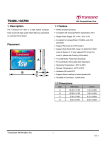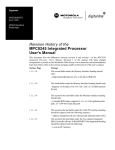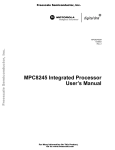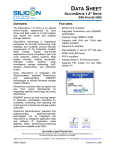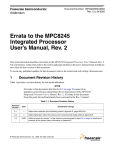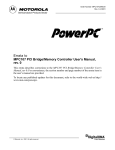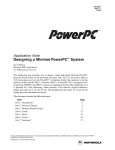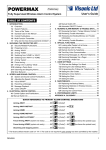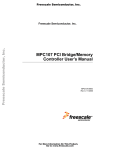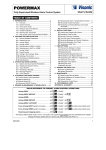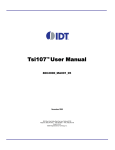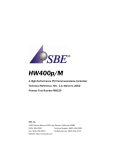Download Compact Flash Interface for the MPC8245
Transcript
Freescale Semiconductor Document Number: AN2293 Rev. 2, 09/2006 Application Note Compact Flash Interface for the MPC8245 by Gary Milliorn CPD Application Freescale Semiconductor, Inc. Austin, TX This application note describes the connections necessary to attach a compact flash device to the MPC8245 embedded microprocessor. The compact flash (CF) standard maintained by the CompactFlash Organization describes a standard way to connect and communicate with compact memory, I/O, and disk drive modules. These devices are often used in embedded systems to provide low-cost mass storage or upgradable OS installations (simply by replacing a CF device and rebooting). CF devices can easily be upgraded with socketed devices or permanently attached with a ‘caged’ connector. CF memory cards are available with up to 512 Mbytes of nonvolatile memory storage and CF miniature hard-disk cards that feature up to 1 GB of storage. There are three classes of CF cards: • PC card memory • PC card I/O • True IDE The PC card memory and true IDE interfaces are popular with embedded systems because of the predictable nature of the devices—raw storage. PC memory cards implement both the memory and true IDE interfaces, and disk drives implement only true IDE interfaces. This application note discusses the design issues for a true IDE device. © Freescale Semiconductor, Inc., 2002, 2006. All rights reserved. Contents Conventions . . . . . . . . . . . . . . . . . . . . . . . . . . . . . . . . . 2 Connections . . . . . . . . . . . . . . . . . . . . . . . . . . . . . . . . . 2 Interface Considerations . . . . . . . . . . . . . . . . . . . . . . . 4 Chip Selects . . . . . . . . . . . . . . . . . . . . . . . . . . . . . . . . .5 Timing Issues . . . . . . . . . . . . . . . . . . . . . . . . . . . . . . . .7 5.1 Read Timing. . . . . . . . . . . . . . . . . . . . . . . . . . . . . . 7 5.2 Write Timing . . . . . . . . . . . . . . . . . . . . . . . . . . . . .10 6 Complete IDE Interface Connections . . . . . . . . . . . . .12 7 Software Setup . . . . . . . . . . . . . . . . . . . . . . . . . . . . . .15 8 References . . . . . . . . . . . . . . . . . . . . . . . . . . . . . . . . . .15 1 2 3 4 5 Conventions All three types are generally described, with differences noted, to assist designers who want only PC memory or PC I/O devices. The connections of the CF card in PC memory and PC I/O modes are similar to those of the IDE mode, but with a different register interface and slight changes of interface signals. Finally, CF devices feature the ability to be hot-plugged (that is, inserted and removed while power is applied). This is not required for most embedded applications, and requires special power sequencing and dynamic signal reconfiguration logic that is far beyond the purpose of this application note. NOTE The VHDL in this application note is compiled and verified with a software test bench but has not been verified in hardware. There may be significant errors in this application note, or the CF test bench may not have revealed latent errors in the example code. Therefore, this application note should be treated as general design information for creating a CF interface and not as a drop-in component. All the software contained in this application note is copyrighted 2002 by Freescale, Inc. and may be used freely by Freescale customers for use on MPC8245-based systems, as long as the copyright notice remains present in each literal or derived module or source file. The code can be freely modified to suit customized applications. You are not obligated to make your own proprietary modifications to the code available to the public, nor to maintain copyrights of your own modifications. 1 Conventions The CF specification uses a ‘-’ prefix to indicate an active-low signal (-XX), while this application note uses an overbar (XX). For VHDL equations, the suffix ‘_B’ indicates an active-low signal, otherwise active-high is assumed. 2 Connections Table 1 summarizes all three signal types of the CF devices. Table 1. CF Device Connections Interface Signal Description Type Pins Notes PC Card Memory PC Card I/O True IDE Common Signals A[10:0] Address I 8, 10, 11, 12, 14, 15, 16, 17, 18, 19, 20 Common CD[1:2] Card detect O 26, 25 Common CS[0:1]/CE[1:2] Chip selects I 7, 32 Common CSEL Cable select I 39 Common 1 2 Compact Flash Interface for the MPC8245, Rev. 2 2 Freescale Semiconductor Preliminary—Subject to Change Without Notice Connections Table 1. CF Device Connections (continued) Interface Signal Description Type Pins Notes PC Card Memory PC Card I/O D[15:0] Data bus I/O 31, 30, 29, 28, 27, 49, 48, 47, 6, 5, 4, 3, 2, 23, 22, 21 Common INPACK Input acknowledge O 43 Common IORD I/O read strobe I 34 Common IOWR I/O write strobe I 35 Common VS[1:2] Voltage sense O 33, 40 Common WAIT/IORDY Wait/ready O 42 Common WE Write enable I 36 Common True IDE 3 Unique Signals ATASEL IDE mode enable I OE Output enable REG Register select I RESET Reset (active-high) I RESET Reset (active-low) IOIS16/IOCS16 16-bit access WP Write protect RDY/BSY Ready/busy IREQ Interrupt request INTRQ Interrupt request BVD1 Bus voltage detect STSCHG Status changed PDIAG Pass diag. BVD2 Bus voltage detect SPKR Speaker DASP Disk active/Slv. Pr. 9 9 9 9 44 9 9 41 9 9 9 O 24 9 9 O 37 9 9 9 9 I/O 46 9 9 9 I/O 45 9 9 9 Power VCC Power (3.3 V) 13, 38 Common Compact Flash Interface for the MPC8245, Rev. 2 Freescale Semiconductor 3 Preliminary—Subject to Change Without Notice Interface Considerations Table 1. CF Device Connections (continued) Interface Signal Ground Description Ground Type Pins Notes PC Card Memory 1, 50 PC Card I/O True IDE Common Notes: 1. A3–A10 must be ground for IDE mode. 2. CS/CE are all chip selects, they just have slightly different names. 3. D15 is the MSB for the CF, while MDH0 is the MSB for the MPC8245. The CF signals are either similar or ‘sideband’ signals implementing unusual controls that can be ignored in many cases. Only a handful must change to control CF memory, I/O, or IDE cards. Designers implementing PC memory or PC I/O modes should be able to adapt to those devices with only slight modifications to the logic in this application note. 3 Interface Considerations The CF specification uses standard CMOS signaling levels; at VCC = 3.3 V, a standard CF device and the MPC8245 can be directly connected with no level translation or high-strength drivers needed. However, on many systems, the MPC8245 PortX interface signals used to control the CF device are also needed to provide address and parity to the SDRAM and boot flash memory, and possibly also control auxiliary flash storage and other devices. Because CF devices are allowed to present a 100-pF load on each signal to ensure the ability to operate at high speeds, a small amount of isolation buffering probably results in a more robust and faster system (refer to Figure 1). Therefore, this application note shows a small buffer on critical signals, but this buffer is only for the purpose noted previously. The buffer can be eliminated if a system timing analysis allows—this is strictly up to the system designer. Because the memory parity signals are used only to implement the higher address lines for the PortX interface, buffering the parity lines is not needed if only the CF IDE interface is used (which uses only A[2:0]). Other signals, such as FWE/FOE, can be lightly loaded and not need additional buffering. Buffers for unidirectional signals such as address and FWE are easily implemented because the buffer can be permanently enabled. For bidirectional data signals, the standard buffer control signals DIR (A/B) and OE should be connected as shown in Figure 1, with logic to control the buffer dependent on how chip selects are implemented. Compact Flash Interface for the MPC8245, Rev. 2 4 Freescale Semiconductor Preliminary—Subject to Change Without Notice Chip Selects SDRAM MPC8245 MA[12:0] An MD[0:63] D[0:63] MDP[0:7] DP[0:7] CS[0:7] CS[0:7] CF Device ’32245 An RCS2 Dn RCS3 Logic FWE DIR FOE OE Figure 1. MPC8245 Buffering 4 Chip Selects The CF devices require two separate chip selects to implement access to data versus control registers or to emulate the two chip selects for IDE status and control. Since the address space requirements of a CF device are less than that provided by the PortX interface, there are two possible ways to provide these chip selects: use RCS2 and RCS3 as a direct connection or use just one of RCS[2:3] with address decode logic to partition the chip select into two. The choice may depend on other system requirements; each has benefits and costs (as shown in Table 2). Table 2. CF True IDE Mode Read Timing Type Mapping Benefits Costs Direct CS0 = RCS2 CS1 = RCS3 Simple CS connections Needs logic to detect RCS2 + RCS3 for address/data buffering Decoded CS0 = RCS2 and MA0 CS1 = RCS2 and!MA0 Logic needed for CS0/CS1 mapping Direct use of RCS for buffer enable Compact Flash Interface for the MPC8245, Rev. 2 Freescale Semiconductor 5 Preliminary—Subject to Change Without Notice Chip Selects For direct CS connection, typical connections for the chip selects and buffer controls are shown in Figure 2. MPC8245 CF Device RCS2 CE0 RCS3 CE1 EN FOE DIR Figure 2. Dual RCS Connections Dual RCS connections can be implemented with the following VHDL code or equivalent: EN_B <= ‘0’ WHEN (RCS2_B = ’0’ AND RCS3_B = ‘0’) ELSE ‘1’; Single RCS controls are shown in Figure 3. MPC8245 CF Device RCS2 CE0 MA0 CE1 EN FOE DIR Figure 3. Single RCS Connections CE0_B <= ‘0’ WHEN (RCS2_B = ’0’ AND MA0 = ‘0’) ELSE ‘1’; CE1_B <= ‘0’ WHEN (RCS2_B = ’0’ AND MA0 = ‘1’) ELSE ‘1’; Since either selection typically requires a small amount of logic, the choice is usually driven by other system design factors. Compact Flash Interface for the MPC8245, Rev. 2 6 Freescale Semiconductor Preliminary—Subject to Change Without Notice Timing Issues 5 Timing Issues An important consideration of the CF interface is the AC timing, both signal-to-signal relationships, and the overall duration of signals. Signal-to-signal relationships are maintained by proper programming of the PortX controller, and will be covered in the following sections. The overall duration of signals becomes an issue when considering the high-speed of the MPC8245 PortX interface (possibly 8 ns clocks with a 133 MHz bus) and the relatively slow speeds allowed by the CF standard. Referring to the overall access times discussed in Section 5.1, “Read Timing” and Section 5.2, “Write Timing,” cycles may take up to 255 ns, or approximately 31 clocks at 133 MHz. Since this is just beyond the limits of the standard mode of the MPC8245 PortX interface, the ‘handshake’ mode is needed. The handshake mode allows PortX cycles to stretch out indefinitely until the DRDY signal is asserted. This mode is not discussed here, as a thorough familiarity with the MPC8245 PortX interface is assumed; refer to Sections 6.3.5 and 6.3.6 of the MPC8245 Integrated Processor User’s Manual. A slight complication of the CF interface is that the IORDY (WAIT) signal, which would be a natural means of controlling the MPC8245 PortX handshake mode, is optional and not mandatory. Bit 11 of the IDE capabilities word indicates whether it is supported or not. Unless only IORDY-compatible devices are used, IORDY is not usable as a sole means of timing control for a general-purpose CF IDE interface. Since it is not clear what percentage of CF devices support IORDY, the control logic incorporates both. 5.1 Read Timing The read access timing waveform is shown in Figure 4, while the parameters and values are shown in Table 3. A[2:0] tlGHAX tlGHEH tAVIGL tELIGL CE tlGLIGH IORD tlGLQV tlGHQX D[15:0] Figure 4. CF True IDE Mode Read Cycle Compact Flash Interface for the MPC8245, Rev. 2 Freescale Semiconductor 7 Preliminary—Subject to Change Without Notice Timing Issues Table 3. CF True IDE Mode Read Timing Timing Parameter Description Min Max Unit tlGLQV Data delay after IORD — 100 ns tlGHQX Data hold following IORD 0 — ns tlGLIGH IORD width time 165 — ns tAVIGL Address setup before IORD 70 — ns tlGHAX Address hold following IORD 20 — ns tELIGL CE setup before IORD 5 — ns tlGHEH CE hold following IORD 20 — ns First, notice is that the overall access time can be as high as 255 ns (tAVIGL + tlGLIGH + tlGHAX). This is just beyond the capability of the MPC8245 Flash/PortX interface operating at 133 MHz, and even then the setup/hold time relationships are not exactly as required. When this is the case, DRDY handshake mode is typically used, as previously detailed. Further examining the waveform and timing values, it is clear there is no required relationship between address and chip select; the MPC8245 PortX interface provides one clock of address setup prior to the chip select, so the address and CE signals can be mapped to the standard PortX MA[20:0] and RCS[2:3] signals. However, since a minimum of 70 ns is required before IORD can be asserted, additional logic is required to implement IORD other than a simple logical function of RCS[2:3] and FWE. To implement the delayed IORD, the ASFALL facility of the PortX interface is used. The signal AS can be programmed to be asserted low, 1 to 15 clocks after the start of any cycle (read or write). By setting ASFALL to (70 ns/bus clock + 1), the AS signal will be asserted low >= 70 ns after the start of any cycle. Additional logic combines AS with RCS[2:3] and FWE to produce the IORD signal. Since AS is typically much shorter in duration than the handshake-controlled RCSn signal, it needs to be latched to extend the duration. Also, RCSn can be delayed, but that takes as much logic as a simple set-reset flip-flop. Similarly, the address signal needs to be maintained after IORD, though data does not. Since the MPC8245 may change the address after releasing RCS[2:3], the ASRISE setting would normally be used to remove the signal one or two clocks early. In handshake mode, the DRDY signal can be used to disable ASRISE early, but if DRDY is not asserted early, the normal ASRISE timing values are in effect. The effect is that AS assertion is usually much shorter than the overall access time, and AS cannot be used by itself (unless the targeted card is guaranteed to work at that speed — this is an optimizable option). The hold time is maintained by the inherent disable time provided by the MPC8245—four to five clocks. Compact Flash Interface for the MPC8245, Rev. 2 8 Freescale Semiconductor Preliminary—Subject to Change Without Notice Timing Issues With these restrictions considered, the interface logic necessary to perform reads is shown in Figure 5. CF Device MPC8245 MA[20:0] A[2:0] RCS[2:3] CE0/CE1 FOE DFF Logic AS IORD DRDY IORDY Delay SDCLK Figure 5. MPC8245 PortX to CF Read Interface The VHDL equations (portions) to implement these functions are: -- CF Read Logic SIGNAL TIMER : std_logic_vector(4 downto 0); SIGNAL ASL_B : std_logic; BEGIN DELAY_RST_B = RCS2_B AND RCS3_B; IORD_B <= ‘0’ WHEN ( RCS2_B = ‘0’ AND ASL_B = ’0’ AND FOE_B = ‘0’ AND DRDY_B = ‘1’) ELSE ‘1’; ASLL : PROCESS( SDCLK, AS_B, DELAY_RST_B ) BEGIN IF (DELAY_RST_B = ‘0’) THEN-- reset ASL_B on RCSx clear ASL_B <= ‘1’; ELSIF (AS_B = ‘0’) THEN-- latch ASL_B on AS_B ASL_B <= ‘0’; END IF; END PROCESS; DELAY : PROCESS( SDCLK, IORDY, DELAY_RST_B ) BEGIN IF (DELAY_RST_B = '0') THEN-- idle timer TIMER <= (others => '0'); Compact Flash Interface for the MPC8245, Rev. 2 Freescale Semiconductor 9 Preliminary—Subject to Change Without Notice Timing Issues ELSIF (IORDY = ‘0’) THEN-- halt timer if not ready TIMER <= TIMER; ELSIF (SDCLK'EVENT AND SDCLK = '1') THEN-- else increment TIMER <= TIMER + ''00001''; END IF; END PROCESS DELAY; DRDY <= ‘0’ WHEN (TIMER >= ''10000'') ELSE ‘1’; Note that DRDY must be asserted low continuously until the RCS[2:3] signals are de-asserted. This is correctly implemented in the preceding equations. For IORDY, when available, if the signal is deasserted (implying it is available), it prevents the timer from incrementing, and thereby triggering DRDY to end the cycle. When IORDY is released, the timer resumes at this point. This allows both IORDY-extensions to the cycle and timer-controlled extensions, with the latter controlling in cases where IORDY is not supported. The timing diagram in Figure 6 shows a CF IDE read cycle as implemented by the MPC8245 PortX interface with accompanying logic. 39,696,400 39,800,000 Group: A a[0:31] = ’h 00000000 00ZzZ* 00ZzZ* 00000000 as_b = 1 asl_b = 0 cfctr = ’h 00000020 00000000 clk = 1 = ’h zzzzzzzz zzzzzzzz drdy_b = 0 foe_b = 0 fwe_b = 1 iord_b = 1 iordy = 1 iowr_b = 1 r_drdy_b = 0 rcs2_b = 0 rcs3_b = 1 39,900,000 40,000,000 40,100,000 00* 40,200,000 40,366,790 ps 0* 00703* 00* 00703* 00000000 B083* 4BFF* Figure 6. MPC8245 CF Read Cycle As expected, the DRDY facility extended the access time well beyond the capabilities of the ROMFAL/ROMNAL settings and allowed the access to take as many cycles as necessary (64 in this example). 5.2 Write Timing The write cycle is similar to the read cycle, except a different control signal is used. The write access timing waveform is shown in Figure 7, while the parameters and values are shown in Table 4. Compact Flash Interface for the MPC8245, Rev. 2 10 Freescale Semiconductor Preliminary—Subject to Change Without Notice Timing Issues A[2:0] tAVIWL tlWHAX tlWHEH tELIWL CE tlWLIWH IOWR tDVIWH tlWHDX D[15:0] Figure 7. CF True IDE Mode Write Cycle Table 4. CF True IDE Mode Write Timing Timing Parameter Description Min Max Unit tDVIWH Data setup before IOWR 60 — ns tIWHDX Data hold following IOWR 30 — ns tlWLIWH IOWR width time 165 — ns tAVIWL Address setup before IOWR 70 — ns tlWHAX Address hold following IOWR 20 — ns tELIWL CE setup before IOWR 5 — ns tlWHEH CE hold following IOWR 20 — ns The restrictions on timing are very similar to that of the read path, except that data must be present before IOWR is released. For write cycles, the interface logic is shown in Figure 8. MPC8245 CF Device MA[20:0] A[2:0] RCS[2:3] CE0/CE1 FWE AS DRDY DFF Logic IOWR Delay IORDY SDCLK Figure 8. MPC8245 PortX to CF Write Interface Compact Flash Interface for the MPC8245, Rev. 2 Freescale Semiconductor 11 Preliminary—Subject to Change Without Notice Complete IDE Interface Connections This is so similar to the read path, that the read and write logic can be combined and the following equations is all that is needed to create a read/write controller for the CF device: IOWR_B <= ‘0’ WHEN ( RCS2_B = ‘0’ AND ASL_B AND FWE_B = ’0’ = ‘0’ AND DRDY_B = ‘1’) ELSE ‘1’; The timing diagram in Figure 9 shows a CF IDE write cycle as implemented by the MPC8245 PortX interface with accompanying logic. 41,564,610 41,700,000 Group: A a[0:31] = ’h 00000000 00Zz* 00000000 as_b = 1 asl_b = 0 cfctr = ’h 00000020 00000000 clk = 1 = ’h zzzzzzzz zzzzzzzz xxxx000000000000 drdy_b = 0 foe_b = 0 fwe_b = 1 iord_b = 1 iordy = 1 iowr_b = 1 r_drdy_b = 0 rcs2_b = 0 rcs3_b = 1 41,800,000 41,900,000 42,000,000 00* 00703* 42,235,000 ps 00* 00703* 00* 00000000 7C80* A083* Figure 9. MPC8245 CF Write Cycle 6 Complete IDE Interface Connections In true IDE mode, the CF device is accessed as if it were an IDE disk drive operating in PIO (non-DMA) modes, with only the corresponding standard complement of eight address lines. Normally, these extra address lines are grounded, but to allow a common interface for true IDE and PC card memory modes, it is sufficient simply to drive the unused address lines to 0x0000 during accesses. Several signals that are unique to operating multiple IDE disk drives (DASP/PDIAG) can be ignored in this application. The IOIS16 signal, for example, is used to indicate 8-bit versus 16-bit accesses and is not needed. Because software can set the extended ROM banks to a 16-bit mode, only 16-bit accesses occur. With these restrictions, the IDE-mode connections can be summarized as shown in Table 5. Table 5. CF IDE Device Connections Signal Description Type Pins A[10:3] Address I A[2:0] Address I 18, 19, 20 CD[1:2] Card detect O 26, 25 Connections 8, 10, 11, 12, 14, 15, To ground 16, 17 To MA[2:0] in same order, through optional but recommended buffer No connect Compact Flash Interface for the MPC8245, Rev. 2 12 Freescale Semiconductor Preliminary—Subject to Change Without Notice Complete IDE Interface Connections Table 5. CF IDE Device Connections (continued) Signal Description Type Pins Connections CS[0:1] Chip selects I 7, 32 To RCS2/RCS3 or to decoder logic CSEL Cable select I 39 D[15:0] Data bus I/O INPACK Input acknowledge O 43 No connect IORD I/O read strobe I 34 To FPGA IOWR I/O write strobe I 35 To FPGA VS[1:2] Voltage sense O 33, 40 IORDY Ready O 42 To FPGA WE Write enable I 36 To VCC (3.3 V) ATASEL IDE mode enable I 9 To ground REG Register select I 44 To VCC (3.3 V) RESET Reset (active-low) I 41 To HRESET or PCIRST IOIS16/IOCS16 16-bit access O 24 No connect INTRQ Interrupt request O 37 Through inverter to IRQ[0:4] PDIAG Pass diag. I/O 46 Pull up, to optional activity LED DASP Disk active/Slv. Pr. I/O 45 No connect VCC Power (3.3 V) — 13, 38 To 3.3 V Ground Ground — 1, 50 To ground To ground 31, 30, 29, 28, 27, To MDH[0:15] through optional but 49, 48, 47, 6, 5, 4, 3, recommended buffer 2, 23, 22, 21 No connect These connections produce a diagram as shown in Figure 10. Compact Flash Interface for the MPC8245, Rev. 2 Freescale Semiconductor 13 Preliminary—Subject to Change Without Notice MPC8245 A MDH[0:15] DIR OE FOE 1/2 LVT32245 Complete IDE Interface Connections A MA[2:0] B D[15:0] B A[2:0] A[10:3] 1/2 LVT32245 MA[20] CF Device OVDD DIR OE CS0 RCS2 CS1 RESET AS DFF HRESET IORD FWE IOWR DRDY IORDY Delay SDCLK REG PDIAG WE +3.3 V +3.3 V +3.3 V IRQ[0:4] INTRQ ATASEL CSEL NC IOIS16 NC INPACK, DASP NC CD[1:2], VS[1:2] Figure 10. CF IDE Interface Compact Flash Interface for the MPC8245, Rev. 2 14 Freescale Semiconductor Preliminary—Subject to Change Without Notice Software Setup 7 Software Setup The MPC8245 PortX interface must be properly programmed before the CF device can be used. The following register fields need to be set to the values shown: ERCR1.RCS2_EN 1-- default ERCR1.RCS2_BURST 0-- non-burst for CF ERCR1.RCS2_DBW 01-- 01=16 bits, though 8 is also possible ERCR1.RCS2_CTL 11-- 11=handshake mode, required ERCR1.ROMFAL 11111-- not used, set to max ERCR1.ROMNAL 11111-- not used, set to max ERCR1.ASFALL 00100-- delay 4 clocks ERCR1.ASRISE 00110-- rise 6 clocks ERCR1.RCS2_TS_WAIT_TIMER 00010-- two cycles between accesses Because AS is latched for reasons previously discussed, the ASRISE parameter is not critical. The RCS3 control register, ERCR2, uses the same settings if it is used with the CF interface. Other register fields (such as Flash location, are application-dependent). After this point, card-specific initialization can be performed. For IDE disk interface devices, the usual sequence is: 1. Issue RESET command to control register. 2. Poll status until not busy. 3. Issue RECALIBRATE command to control register. 4. Poll status until not busy. 5. Issue IDENTIFY command to control register. 6. Poll status until not busy. 7. Read 256 words of data from command pointer. Now application programs can read and write data and commands to the device. Usually the desired 512-byte block of data is indexed using the LBA (Logical Block Address), a 28-bit address. Note that the MPC8245 cannot boot from the CF device. The EXTROM port is used, and this requires software setup. A small boot-loader can initialize the PortX interface and then jump. 8 References This section lists additional reference information: • MPC8245 documentation, refer to www.freescale.com — MPC8245 Integrated Processor User’s Manual — MPC8245 Integrated Processor Hardware Specifications • CompactFlash Specifications, refer to www.compactflash.org/ • For reference purposes, many designers may refer to application notes and example/reference designs available on the Freescale website. Compact Flash Interface for the MPC8245, Rev. 2 Freescale Semiconductor 15 Preliminary—Subject to Change Without Notice How to Reach Us: Home Page: www.freescale.com email: [email protected] USA/Europe or Locations Not Listed: Freescale Semiconductor Technical Information Center, CH370 1300 N. Alma School Road Chandler, Arizona 85224 1-800-521-6274 480-768-2130 [email protected] Information in this document is provided solely to enable system and software implementers to use Freescale Semiconductor products. There are no express or implied copyright licenses granted hereunder to design or fabricate any integrated circuits or integrated circuits based on the information in this document. Europe, Middle East, and Africa: Freescale Halbleiter Deutschland GmbH Technical Information Center Schatzbogen 7 81829 Muenchen, Germany +44 1296 380 456 (English) +46 8 52200080 (English) +49 89 92103 559 (German) +33 1 69 35 48 48 (French) [email protected] Freescale Semiconductor reserves the right to make changes without further notice to Japan: Freescale Semiconductor Japan Ltd. Headquarters ARCO Tower 15F 1-8-1, Shimo-Meguro, Meguro-ku Tokyo 153-0064, Japan 0120 191014 +81 3 5437 9125 [email protected] parameters, including “Typicals” must be validated for each customer application by Asia/Pacific: Freescale Semiconductor Hong Kong Ltd. Technical Information Center 2 Dai King Street Tai Po Industrial Estate, Tai Po, N.T., Hong Kong +800 2666 8080 [email protected] unauthorized application, Buyer shall indemnify and hold Freescale Semiconductor For Literature Requests Only: Freescale Semiconductor Literature Distribution Center P.O. Box 5405 Denver, Colorado 80217 1-800-441-2447 303-675-2140 Fax: 303-675-2150 LDCForFreescaleSemiconductor @hibbertgroup.com Freescale™ and the Freescale logo are trademarks of Freescale Semiconductor, Inc. The Power Architecture and Power.org word marks and the Power and Power.org logos and related marks are trademarks and service marks licensed by Power.org. All other product or service names are the property of their respective owners. Document Number: AN2293 Rev. 2 09/2006 Preliminary—Subject to Change Without Notice any products herein. Freescale Semiconductor makes no warranty, representation or guarantee regarding the suitability of its products for any particular purpose, nor does Freescale Semiconductor assume any liability arising out of the application or use of any product or circuit, and specifically disclaims any and all liability, including without limitation consequential or incidental damages. “Typical” parameters which may be provided in Freescale Semiconductor data sheets and/or specifications can and do vary in different applications and actual performance may vary over time. All operating customer’s technical experts. Freescale Semiconductor does not convey any license under its patent rights nor the rights of others. Freescale Semiconductor products are not designed, intended, or authorized for use as components in systems intended for surgical implant into the body, or other applications intended to support or sustain life, or for any other application in which the failure of the Freescale Semiconductor product could create a situation where personal injury or death may occur. Should Buyer purchase or use Freescale Semiconductor products for any such unintended or and its officers, employees, subsidiaries, affiliates, and distributors harmless against all claims, costs, damages, and expenses, and reasonable attorney fees arising out of, directly or indirectly, any claim of personal injury or death associated with such unintended or unauthorized use, even if such claim alleges that Freescale Semiconductor was negligent regarding the design or manufacture of the part. © Freescale Semiconductor, Inc., 2002, 2006.


















